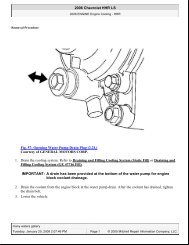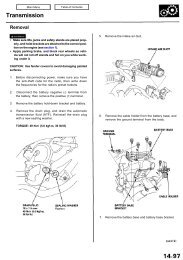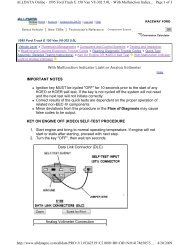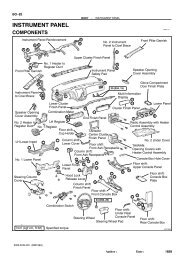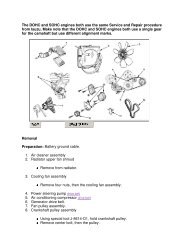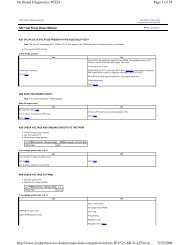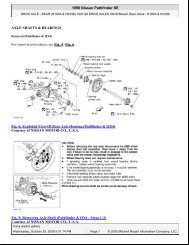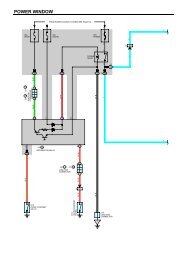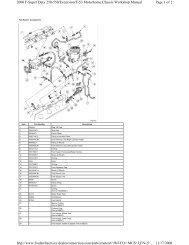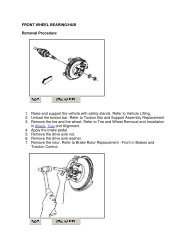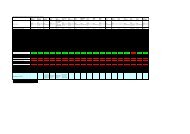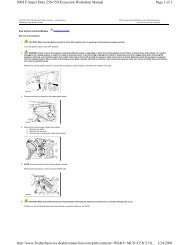3–62–1. ADULTERY (ARTICLE 134) (1) That (state the ... - JustAnswer
3–62–1. ADULTERY (ARTICLE 134) (1) That (state the ... - JustAnswer
3–62–1. ADULTERY (ARTICLE 134) (1) That (state the ... - JustAnswer
Create successful ePaper yourself
Turn your PDF publications into a flip-book with our unique Google optimized e-Paper software.
<strong>3–62–1.</strong> <strong>ADULTERY</strong> (<strong>ARTICLE</strong> <strong>134</strong>)<br />
a. MAXIMUM PUNISHMENT: DD, TF, 1 year, E-1.<br />
b. MODEL SPECIFICATION:<br />
In that __________ (personal jurisdiction data), __________, (a married man/a married woman), did, (at/on<br />
b o a r d — l o c a t i o n ) , o n o r a b o u t _ _ _ _ _ _ _ _ _ _ , w r o n g f u l l y h a v e s e x u a l i n t e r c o u r s e w i t h _ _ _ _ _ _ _ _ _ _ , a<br />
(married) man/woman not her husband/his wife.<br />
c. ELEMENTS:<br />
(1) <strong>That</strong> (<strong>state</strong> <strong>the</strong> time and place alleged), <strong>the</strong> accused wrongfully had<br />
sexual intercourse with (<strong>state</strong> <strong>the</strong> name of <strong>the</strong> (man) (woman) alleged);<br />
(2) <strong>That</strong>, at <strong>the</strong> time, (<strong>the</strong> accused was married to ano<strong>the</strong>r) (and) (<strong>state</strong><br />
<strong>the</strong> name of <strong>the</strong> (man) (woman) alleged) was married to ano<strong>the</strong>r); and<br />
(3) <strong>That</strong>, under <strong>the</strong> circumstances, <strong>the</strong> conduct of <strong>the</strong> accused was to<br />
<strong>the</strong> prejudice of good order and discipline in <strong>the</strong> armed forces or was<br />
of a nature to bring discredit upon <strong>the</strong> armed forces.<br />
d. DEFINITIONS AND OTHER INSTRUCTIONS:<br />
C o n d u c t p r e j u d i c i a l t o g o o d o r d e r a n d d i s c i p l i n e i s c o n d u c t w h i c h<br />
c a u s e s a r e a s o n a b l y d i r e c t a n d o b v i o u s i n j u r y t o g o o d o r d e r a n d<br />
discipline. Service discrediting conduct is conduct which tends to harm<br />
<strong>the</strong> reputation of <strong>the</strong> service or lower it in public esteem.<br />
“Sexual intercourse” is any penetration, however slight, of <strong>the</strong> female<br />
sex organ by <strong>the</strong> penis. An ejaculation is not required.<br />
NOTE 1: Lack of penetration in issue. If lack of penetration is in issue, <strong>the</strong> military judge<br />
should fur<strong>the</strong>r define what is meant by <strong>the</strong> female sex organ. The instruction below may be<br />
helpful. See also United States v. Williams, 25 M.J. 854 (A.F.C.M.R.), pet. denied, 27 M.J. 166<br />
(1988) and United States v. Tu, 30 M.J. 587 (A.C.M.R. 1990).<br />
The “female sex organ” includes not only <strong>the</strong> vagina, which is <strong>the</strong> canal<br />
that connects <strong>the</strong> uterus to <strong>the</strong> external opening of <strong>the</strong> genital canal,<br />
but also <strong>the</strong> external genital organs including <strong>the</strong> labia majora and <strong>the</strong><br />
labia minora. “Labia” is <strong>the</strong> Latin and medically correct term for “lips.”<br />
NOTE 2: Prejudicial or service discrediting nature of <strong>the</strong> offense. To constitute an offense<br />
under <strong>the</strong> Uniform Code of Military Justice, <strong>the</strong> adultery must ei<strong>the</strong>r be directly prejudicial<br />
DA PAM 27–9, CHANGE 2 01 July 2003<br />
<strong>ARTICLE</strong> <strong>134</strong><br />
591
<strong>ARTICLE</strong> <strong>134</strong><br />
to good order and discipline or service discrediting. When this element is in issue, <strong>the</strong><br />
following instruction should be given:<br />
Not every act of adultery constitutes an offense under <strong>the</strong> Uniform<br />
Code of Military Justice. To constitute an offense, <strong>the</strong> government<br />
must prove beyond a reasonable doubt that <strong>the</strong> accused’s adultery<br />
was ei<strong>the</strong>r directly prejudicial to good order and discipline or service<br />
discrediting<br />
"Conduct prejudicial to good order and discipline" includes adultery that<br />
h a s a n o b v i o u s a n d m e a s u r a b l y d i v i s i v e e f f e c t o n t h e d i s c i p l i n e ,<br />
morale, or cohesion of a military unit or organization, or that has a<br />
clearly detrimental impact on <strong>the</strong> authority, stature, or esteem of a<br />
servicemember. "Service discrediting" conduct includes adultery that<br />
has a tendency, because of its open or notorious nature, to bring <strong>the</strong><br />
service into disrepute, to make it subject to public ridicule, or to lower it<br />
in public esteem.<br />
Under some circumstances, adultery may not be prejudicial to good<br />
order and discipline but, none<strong>the</strong>less, may be service discrediting, as I<br />
h a v e e x p l a i n e d t h o s e t e r m s t o y o u . L i k e w i s e , d e p e n d i n g o n t h e<br />
circumstances, adultery can be prejudicial to good order and discipline<br />
but not be service discrediting.<br />
In determining whe<strong>the</strong>r <strong>the</strong> alleged adultery in this case is prejudicial to<br />
good order and discipline or is of a nature to bring discredit upon <strong>the</strong><br />
armed forces, you should consider all <strong>the</strong> facts and circumstances<br />
offered on this issue, including, but not limited to:<br />
(<strong>the</strong> accused’s marital status, military rank, grade, or position);<br />
( t h e c o - a c t o r ’ s m a r i t a l s t a t u s , m i l i t a r y r a n k , g r a d e , o r p o s i t i o n , o r<br />
relationship to <strong>the</strong> armed forces);<br />
(<strong>the</strong> military status of <strong>the</strong> accused’s spouse or <strong>the</strong> co-actor’s spouse,<br />
or <strong>the</strong>ir relationship to <strong>the</strong> armed forces);<br />
(<strong>the</strong> impact, if any, of <strong>the</strong> adulterous relationship on <strong>the</strong> ability of <strong>the</strong><br />
592 DA PAM 27–9, CHANGE 2 01 July 2003
accused, <strong>the</strong> co-actor, or <strong>the</strong> spouse of ei<strong>the</strong>r to perform <strong>the</strong>ir duties in<br />
support of <strong>the</strong> armed forces)<br />
(<strong>the</strong> misuse, if any, of government time and resources to facilitate <strong>the</strong><br />
commission of <strong>the</strong> adultery);<br />
(whe<strong>the</strong>r <strong>the</strong> adultery persisted despite counseling or orders to desist;<br />
t h e f l a g r a n c y o f t h e a d u l t e r o u s r e l a t i o n s h i p , s u c h a s w h e t h e r a n y<br />
notoriety ensued; and whe<strong>the</strong>r <strong>the</strong> adultery was accompanied by o<strong>the</strong>r<br />
violations of <strong>the</strong> UCMJ);<br />
(<strong>the</strong> impact of <strong>the</strong> adultery, if any, on <strong>the</strong> units or organizations of <strong>the</strong><br />
accused, <strong>the</strong> co-actor or <strong>the</strong> spouse of ei<strong>the</strong>r of <strong>the</strong>m, such as a<br />
d e t r i m e n t a l e f f e c t o n u n i t o r o r g a n i z a t i o n m o r a l e , t e a m w o r k , a n d<br />
efficiency);<br />
(whe<strong>the</strong>r <strong>the</strong> accused or co-actor was legally separated);<br />
(whe<strong>the</strong>r <strong>the</strong> adultery involves an ongoing or recent relationship or is<br />
remote in time);<br />
(where <strong>the</strong> adultery occurred)<br />
(who may have known of <strong>the</strong> adultery)<br />
(<strong>the</strong> nature, if any, of <strong>the</strong> official and personal relationship between <strong>the</strong><br />
accused and (name of co-actor))<br />
(________________)<br />
NOTE 3: Marriage. If <strong>the</strong> evidence raises <strong>the</strong> issue whe<strong>the</strong>r ei<strong>the</strong>r <strong>the</strong> accused or <strong>the</strong> coactor<br />
are actually married, instruct as follows:<br />
A marriage exists until it is dissolved in accordance with <strong>the</strong> laws of a<br />
competent <strong>state</strong> or foreign jurisdiction.<br />
NOTE 4: O<strong>the</strong>r instructions. Instruction 7-3, Circumstantial Evidence (Knowledge), may be<br />
applicable as to <strong>the</strong> manner of proof that <strong>the</strong> accused knew of <strong>the</strong> marital status of his/her<br />
co-actor or <strong>the</strong> prejudicial or service discrediting nature or effect of <strong>the</strong> conduct.<br />
NOTE 5: Mistake of fact. If <strong>the</strong> evidence raises <strong>the</strong> issue that <strong>the</strong> accused may have<br />
mistakenly believed ei<strong>the</strong>r that <strong>the</strong> accused and <strong>the</strong> co-actor were both unmarried or that<br />
DA PAM 27–9, CHANGE 2 01 July 2003<br />
<strong>ARTICLE</strong> <strong>134</strong><br />
592.1



